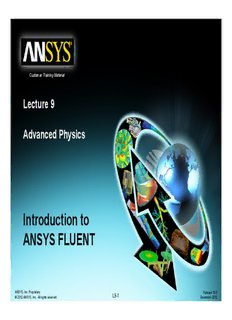
Introduction to Introduction to ANSYS FLUENT - iMechanica PDF
Preview Introduction to Introduction to ANSYS FLUENT - iMechanica
Customer Training Material LLectture 99 Advanced Phyysics IInnttrroodduuccttiioonn ttoo ANSYS FLUENT ANSYS, Inc. Proprietary Release 13.0 L9-1 © 2010 ANSYS, Inc. All rights reserved. December 2010 Advanced Modelling Options Outline Customer Training Material • Multiphase Flow Modelling – Discrete phase model – Eulerian model – MMiixxttuurree mmooddeell – Volume-of-Fluid (VOF) model • Reacting Flow Modelling – Eddy dissipation model – Non-premixed, premixed and partially premixed combustion models – Detailed chemistry models – Pollutant formation – Surface reactions • Modelling Moving Parts – SSiinglle andd mullttiiplle refference fframes – Mixing planes – Sliding meshes – Dyynamic meshes – Six-degree-of-freedom solver ANSYS, Inc. Proprietary Release 13.0 L9-2 © 2010 ANSYS, Inc. All rights reserved. December 2010 Advanced Modelling Options Customer Training Material Multiphase Flows ANSYS, Inc. Proprietary Release 13.0 L9-3 © 2010 ANSYS, Inc. All rights reserved. December 2010 Advanced Modelling Options Multiphase Flows - Introduction Customer Training Material • In many flows, there is more than one fluid present in the domain – Different substances (eg oil & water, or methane & air) – Different phases of same substance (water & steam) • The keyy issue is how these two fluids are mixed – If they are mixed at a molecular level, the problem is a multi-species flow. – A common example is where two gases are present (methane and air) – A diffusivityy ((‘material pproppertyy’)) is set for the mixture,, and one extra transpport equation is solved for the mass fraction of primary component. – If the mixing is more macroscopic, then it is a multiphase flow. – In such cases there is an identifiable boundary between the two phases – The user must therefore indicate to the solver how this boundary performs maybe a free surface (VOF model), or a typical droplet size (mixture model) ANSYS, Inc. Proprietary Release 13.0 L9-4 © 2010 ANSYS, Inc. All rights reserved. December 2010 Advanced Modelling Options Multiphase Flows - Introduction Customer Training Material • The fluid system is defined by a primary and multiple secondary phases. – One of the phases is considered continuous (primary) – The others (secondary) are considered to be dispersed within the continuous phase. – (Note that for free-surface flows, using the Volume of Fluid model, a distinct interface is defined between the phases and both could be considered ccoonnttiinnuuoouuss)) Secondary phase(s) Primary Phase ANSYS, Inc. Proprietary Release 13.0 L9-5 © 2010 ANSYS, Inc. All rights reserved. December 2010 Advanced Modelling Options Multiphase Flow Regimes Customer Training Material – Bubbly flow – Discrete gaseous bubbles in a continuous fluid, e.g. absorbers, evaporators, sparging devices. – DDrroopplleett ffllooww – DDiissccrreettee fflluuiidd ddrroopplleettss iinn aa continuous gas, e.g. atomizers, combustors Slug Flow Bubbly, Droplet, or Gas/Liquid Liquid/Liquid – Slug flow – Large bubbles in a continuous Particle-Laden Flow lliiqquuiidd – Stratified / free-surface flow – Immiscible fluids separated by a clearly defined interface, e.g. free-surface flow Stratified / Free- Pneumatic Transport, – Particle-laden flow – Discrete solid Surface Flow Hydrotransport, or Slurry Flow particles in a continuous fluid, e.g. cyclone Gas / Solid separators, air classifiers, dust collectors, dust-laden environmental flows – Fluidized beds – Fluidized bed reactors – SSlluurrrryy ffllooww – PPaarrttiiccllee ffllooww iinn lliiqquuiiddss, ssoolliiddss Liquid / Solid suspension, sedimentation, and hydro- Sedimentation Fluidized Bed transport ANSYS, Inc. Proprietary Release 13.0 L9-6 © 2010 ANSYS, Inc. All rights reserved. December 2010 Advanced Modelling Options Multiphase Models Available in FLUENT Customer Training Material • FLUENT contains four distinct multiphase modeling approaches: – Discrete Phase Model (DPM) – Volume of Fluid Model (VOF) – Eulerian Model – Mixture Model • It is important to select the most appropriate modelling approach when attempting to model a multiphase flow. – Deppends on whether the flow is stratified or dispperse – lenggth scale of the interface between the phases dictates this. – Also the Stokes number (the ratio of the particle relaxation time to the characteristic time scale of the flow) should be considered. where and . ANSYS, Inc. Proprietary Release 13.0 L9-7 © 2010 ANSYS, Inc. All rights reserved. December 2010 Advanced Modelling Options DPM Example – Spray Dryer Customer Training Material • Spray drying involves the transformation of a liquid spray into dry powder in a heated chamber. The flow, heat, and mass transfer are simulated using the DPM model in FLUENT. Initial particle 1.1 mm 0.2 mm Contours of Diameter: 2 mm Evaporated Water Stochastic Particle Trajectories for Different Initial Diameters ANSYS, Inc. Proprietary Release 13.0 L9-8 © 2010 ANSYS, Inc. All rights reserved. December 2010 Advanced Modelling Options Eulerian Model Example – 3D Bubble Column Customer Training Material z = 20 cm z = 15 cm z = 10 cm z = 5 cm Isosurface of Gas Liquid Velocity Vectors Volume Fraction = 0.175 ANSYS, Inc. Proprietary Release 13.0 L9-9 © 2010 ANSYS, Inc. All rights reserved. December 2010 Advanced Modelling Options The Granular Option in the Eulerian Model Customer Training Material • Granular flows occur when a high concentration of solid particles is present. This leads to high frequency of interparticle collisions. • Particles are assumed to behave similarly to a dense cloud of colliding molecules. Molecular cclloouudd tthheeoorryy iiss aapppplliieedd ttoo tthhee ppaarrttiiccllee pphhaassee. Gravity • Application of this theory leads to the appearance of additional stresses in the momentum eqquations for continuous and particle phases – These stresses (granular “viscosity”, “pressure” etc.) are determined by intensity of particle velocity fflluuccttuuaattiioonnss – Kinetic energy associated with particle velocity Gas / Sand fluctuations is represented by a “pseudo-thermal” or Gas granular temperature – Inelasticity of the granular phase is taken into Contours of Solids Volume account Fraction for High Velocity Gas/Sand Production ANSYS, Inc. Proprietary Release 13.0 L9-10 © 2010 ANSYS, Inc. All rights reserved. December 2010
Description: